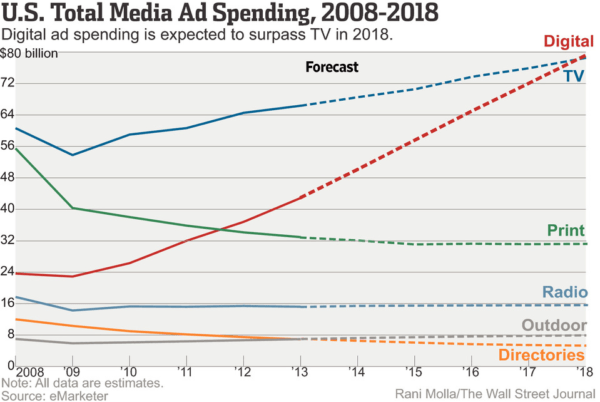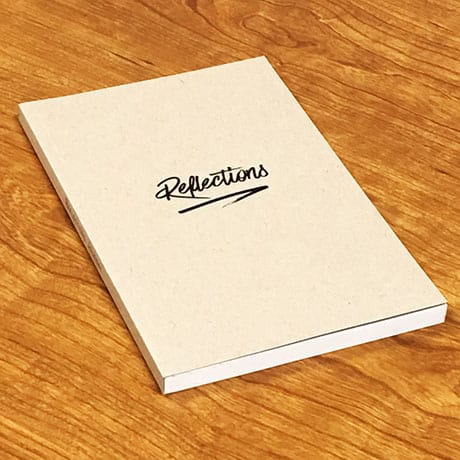It’s news to some people: print advertising is sticking around. But methods of measuring the advertising effectiveness of print is changing. Or, it should be.
Studies show that we consumers are neurologically disposedto respond better to print ads in certain situations – and this is not just true of the old folks, either. Studies showthat while Millennials are more influenced by digital ads than other age groups, they pay more attention to traditional ads.
Recently, the Wall Street Journalreleased the following chart, and it’s no surprise that ad spending on print has dropped in recent years while spending on digital ads has accelerated. But look at what happens to print in the next few years: print spending will remain around the same level where it is today.

Print clearly will remain a major advertising player. For it to complement digital and other types of advertising we must focus on better ways of reporting the effectiveness of print advertising. Particularly, we must be able to measure the ROI of print not only on its own, but also in relation to other advertising platforms. Of course, this is easier said than done.
One of the clear advantages of digital advertising is how easy it is to gather data about the performance of ads. When a potential customer clicks on your ad, you can see not only exactly where they came from to get to your site, but also how they then interact once on your site. When enough data is collected you can adjust your marketing plan accordingly.
The Difficulties in Measuring Advertising Effectiveness in Print
Print advertising, however, is not always so simple to quantify.
The use of a QR code once seemed like the answer; the natural link between print and digital. Just like a click on the digital ad, the information transferred from a QR scan provides a wealth of information about where the consumer viewing the ad came from.
But the codes have never taken off with the public as much as marketers might like. Even the inventor of the code recently said it (the code) only has a decade or so left to live. Though he was referring to the original use of the codes in warehouse and manufacturing settings, it is likely that the same is true for advertising.
So we are left to focus on creating better methods to measure the performance of print advertising.
A New Kind of Measurement Tool
A new tool that aims to offer new insights into print advertising effectiveness is the Magazine Audience Performing Predictor (mapp), which delivers performance data of magazine ads within 14 days of the issue’s on-sale date. This is as close to real time performance results for magazine ads as we currently have available. A collaborative effort of Magazine Publishers of Australia (MPA) – and thus far only available for Australian magazines – the tool recently received a global award at the FIPP Research Forum.

Here’s the description of the tool on the MPA website:
Using mapp advertisers can now access timely, real-time measures of current magazine issue performance and magazine audience build over time. [It] enables magazines to be evaluated more accurately in advertisers’ marketing and media models, using a weekly timeframe of performance, alongside other media and key indicators, such as sales. mapp provides, within a week or two after the on-sale date, estimates of the total ratings that specific magazine issues will achieve over their lifespan.
“mapp is a truly innovative project, which quantifies the contribution of magazines to the media mix in a manner that is in line with the forms of data available for other media,” said FIPP’s judges, according to ProPrint.com. “It involves forecasting how advertising messages in magazines will be spread through time, issue by issue.”
What’s Next?
The service is still relatively new, so its effectiveness remains to be seen. Still, it’s great to see innovations coming to magazine ad measuring techniques.
As print spending stabilizes, advertisers will have a better idea of how much they need to spend on print, but the new question will be what print venues will be the best investment. And they will be looking to new tools like mapp to help them make these decisions.
The Future is Cross Platform
As mentioned above, print advertisers not only want better ROI measurements, but also want to know how these ads function in context of their other advertising platforms. Forbesemphasized the importance of measuring multiple platforms at once with the article, “2014: The Year of the Cross Platform Measurement.”
Much of the article is focused on traditional television vs. digital video consumption. But the parallels to the print medium are many. Television advertisers are still relying heavily on the traditional ratings measurement tools, while the rise of digital television consumption is sharp (a 30 percent rise from the final quarter of 2012 to the final quarter of 2013). Needless to say, it is now imperative to not only be able to measure both traditional and digital TV viewing, but to be able to be able to combine that data to get an accurate picture of the viewing audience.
Similarly, print advertisers still rely primarily on circulation numbers that are becoming more and more unreliable as reading habits change. While it is easier to measure digital reading habits, being able to discover what reader is reading one article in a magazine and then another (in the same publication) online will put advertisers in a much better position. It will also be a great way for publishers to give advertisers a better representation of not only how many but howreaders are reading the material. Of course, this will allow them to better optimize advertising rates.
What Does it Mean Now?
The good news: print advertising is sticking around and the previous decline in print ad sales will level off. This means advertisers are realizing where the advantages of print advertising lies in relation to digital ads and how the two can complement each other.
The bad news: we don’t yet have a great way to measure the results of this cross-platform approach.
However, it is likely that new tools similar to mapp will continue to emerge to fill this void. It remains to be seen just how effective they will be, but we’ll be looking forward to seeing more effective print advertising measuring techniques emerge as we move forward into this new era of advertising.





